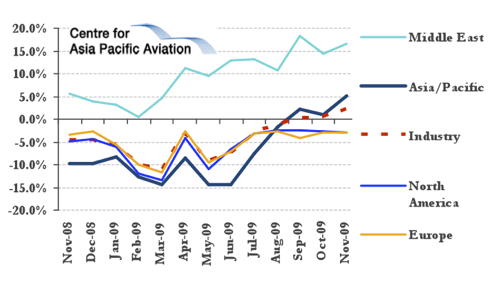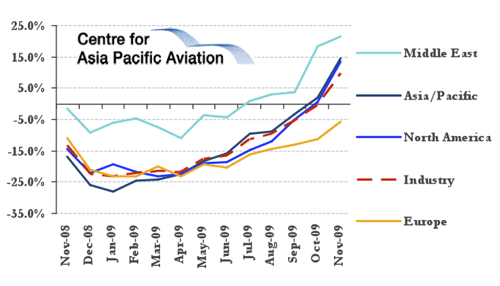The world’s airlines still in survival mode - IATA
The International Air Transport Association (IATA) reported international scheduled traffic (RPKs) rose 2.1% year-on-year in Nov-2009, while freight demand recorded a 9.5% improvement. Director General and CEO, Giovanni Bisignani, stated, "demand continues to improve, but we still have a lot of ground still to recover". He added, "we cannot anticipate any significant improvement in yields in the coming months, so conserving cash, controlling costs and carefully matching capacity to demand remain at the keys to survival".
Still well below pre-crisis levels
IATA noted that passenger load factors were still at pre-crisis levels of 75.4% in Nov-2009, while freight load factors stood at just 56.6%.
Passenger demand is 6.4% better than the low point reached in 1Q2009, but still 6% below the peak levels seen in early 2008. Freight demand is 20% better than the low point in Dec-2008, but still 10% below the peak levels seen in early 2008.
Comparing to October (and adjusting for seasonality), passenger demand in November actually fell by 0.7%, primarily due to continued weakness in North America and Europe. The Conference Board stated the recent slowing of the trend in the Euro Area's Leading Economic Index "reinforces concerns about a fragile recovery" in that region, while concerns persist about the strength of the US economic recovery.
Significant variances by region
In Nov-2009, demand growth was recorded by carriers from the Asia Pacific region (+5.1%), Latin America (+8.2%) and the Middle East (+16.5%).
Asian air traffic growth is driven most directly by economic recovery (with the exception of Japan), while Asian economic growth is fuelling strong demand for commodities in both Latin America and Africa, according to the airline body.
While Latin American carriers are benefiting with business growth, a 2.1% fall in African traffic indicates a loss in market share. Middle East growth of 16.5% "can also be related to the strength of Asia and the ability of Middle East carriers to facilitate connection traffic to the region through Middle Eastern hubs".
IATA international passenger traffic growth: Nov-2008 to Nov-2009

European and North American carriers both experienced a 3.0% fall in Nov-2009 passenger traffic. Unemployment concerns continue to negatively impact consumer confidence in both markets, according to IATA. Compared to last November, European carriers have cut capacity by 3.9% and North American carriers by 6.7%. While this has boosted load factors, capacity adjustments may also be weighing on growth rates.
International Freight Demand
IATA stated the 14.5% growth in freight demand for Asia Pacific carriers in Nov-2009 was "linked to the success of stimulus packages in driving industrial output and broader economic recovery within the region".
Carriers in other regions also saw strong growth in freight as follows: Africa (+8.1%), Latin America (+17.5%), Middle East (+21.4%) and North America (+13.6%).
European carriers were the only group to post a drop in traffic, recording a 5.6% fall in demand. This reflects the "lingering economic malaise" in the region, according to IATA.
IATA international freight traffic growth: Nov-2008 to Nov-2009
